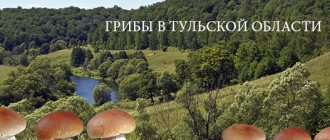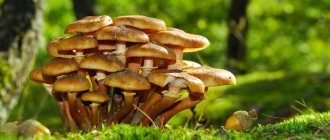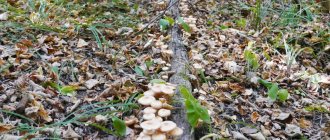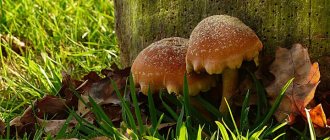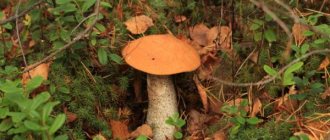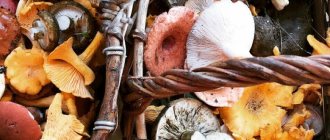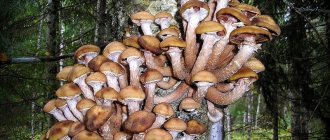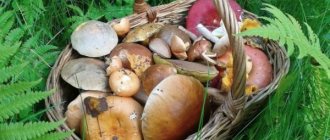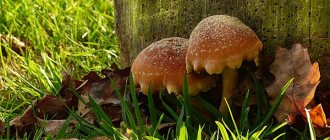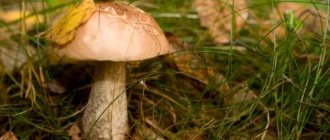The Orenburg region is located in the steppe zone. Forests occupy less than 5% of its area, almost half in the Northern and Buzuluk regions. A significant addition is artificial field protection and erosion control plantings.
Despite the small area of forests, in a favorable (fairly rainy) season, mushroom hunting in the Orenburg region can be very successful. The composition of the tracts and their quality create all the conditions for mushroom abundance. In the east of the region, in the upper reaches of the Suunduk River, there are pine woodlands. The floodplains of the Samara, Ural and Sakmar rivers are decorated with extensive oak forests. Forest islands in the forest-steppe zone consist of oak, linden and birch, with which representatives of the mushroom kingdom love to cooperate.
Biologists called this variant of plant symbiosis “mycorrhiza” (Greek “fungal root”). It consists in the fact that the mycelium, with the help of tiny shoots, is embedded in the roots of the tree, forming a system of mutually beneficial exchange of useful substances, receiving additional nutrition from it. At the same time, processing organic matter into a form that is more easily digestible for the tree (even sugars) and protecting the roots from pathogens, producing something like antibiotics.
Edible mushrooms
The climatic features of the Orenburg region favor lovers of “silent hunting”, who collect mushrooms from May until late autumn. This area is rich in many edible and inedible varieties.
Some of them can be consumed fresh, including russula and champignons. Collection areas are deciduous, mixed and coniferous forests. The number of mushrooms depends on the season.
White
With the onset of autumn, avid mushroom pickers go on a “hunt” for porcini mushrooms. Their value lies in their high taste and calorie content. Another name for the species is boletus. The forms of the porcini mushroom differ depending on the habitat, the color of the cap and its shape, as well as features in the external structure of the stem (hemp).
It is quite easy to recognize them - by their characteristic brown or brownish cap and light-colored stem. The color of the snow-white pulp becomes darker when pressed.
Due to the fact that the pulp of the porcini mushroom does not change its color when dried, mushroom soups will always be transparent.
Boletus
Popular edible mushrooms growing near deciduous trees. Their season starts in the last weeks of summer and lasts until the end of October. It is advisable to collect edible specimens before the start of the rainy season, since moisture can cause them to become wormy.
The species is recognized by its fleshy cap of a brownish hue, which has a tubular structure on the reverse side. The leg is covered with small grayish scales. Sometimes they are confused with boletus mushrooms and very rarely with porcini mushrooms - if the boletus leg is thick in comparison with its usual shape and size.
Milk mushrooms
Common edible mushrooms in the Orenburg region are yellow and black milk mushrooms. The first species is recognized by the yellow tint of the cap, and the second by its olive-brown color. According to the description, the cap of young specimens is spherical, while that of older specimens is slightly concave.
Irina Selyutina (Biologist):
The yellow breast is often called the yellow breast. Birch and, less commonly, coniferous forests are common to it. This mushroom is collected from July to September inclusive. The flesh of the mushroom is white, turning yellow when cut, as does the white acrid milky juice present in the pulp (it turns yellow when it comes into contact with air in dry weather, but not in rainy weather). This type of milk mushroom is consumed salted and pickled. It tastes no different from real milk mushrooms. The specific bitterness characteristic of milk mushrooms is eliminated by soaking and heat treatment.
This mushroom is classified in category 1, although it is called conditionally edible due to the presence of caustic milky juice.
Growing in deciduous and coniferous forests, milk mushrooms serve as a nutritious delicacy.
Champignon
Even city residents know the champignons growing in forest glades in Orenburg. They are often used in preparing a variety of dishes and are sold in every grocery store.
You can distinguish the mushroom from others by its spherical cap, which has a dense structure. The pulp crushes easily under pressure and is pinkish or white.
In addition to the above-mentioned species, in the Orenburg region you can collect a lot of useful and tasty mushrooms: saffron caps, chanterelles, boletus, honey mushrooms, and also: rubellas, rows, moss mushrooms, morels and other mushrooms. Local residents, familiar with them since childhood, very easily distinguish between edible and poisonous species, but tourists are better off picking only what is familiar and not taking risks.
Read also: Gave a flower for female happiness
Ramaria yellow
The appearance of this mushroom with a beautiful name is the most unusual, since it resembles yellow coral. It reaches a height of 15-20 cm, the smell has a herbal, not pronounced taste. Only young mushrooms should be eaten - after preliminary boiling for 10 minutes, they can be cooked: boiled, fried and salted. But the old ones are not suitable for these purposes - they begin to taste bitter.
Golden scale
The range is the entire territory of Russia, including the Orenburg region. This species grows in large groups on or near deciduous trees. Most often, representatives of the species can be found in China.
Mushroom picker calendar
In the Orenburg region, mushroom hunters can engage in their gambling from April until the end of October, choosing promising places and hunting objects depending on the weather.
- The first to delight experienced mushroom pickers are the intricate morels. They appear from last year's litter in April, as soon as the snow melts. But with the beginning of a full-fledged mushroom season, it becomes much more difficult to find them - they cannot withstand competition with other representatives of the mushroom kingdom.
- But champignons, having appeared almost simultaneously with morels, fill the baskets until the fall - if you know the good places.
- In a good year (warm and rainy), you can go for porcini mushrooms and mushrooms as early as mid-June. But the best time for them is July and August.
- Mushrooms for pickling (milk mushrooms, saffron milk caps, mushrooms) love the autumn coolness. It happens that they are collected from wet lowlands even in early November, after the first short frosts. But the best time for them is the end of August - September.
- Milk mushrooms, honey mushrooms and rows are very fond of the November coolness.
Poisonous mushrooms
Fly agaric is easy to recognize by its appearance
In the forests of the Orenburg region, not only edible species are found, but also poisonous ones. The main difference between the latter is the inability to eat. They contain natural toxins that are dangerous to humans. The consequence of poisoning can be death.
There are 5 of the most famous mushrooms in Orenburg.
- Pale toadstools: a deadly poisonous species that can inadvertently be confused with good mushrooms. It perfectly disguises itself as champignons and russula. The color of the cap can be light green, white, yellowish-brown-olive. The diameter of the cap is 10 cm, the flesh is white, odorless and tasteless.
- Fly agarics: a less poisonous mushroom, unlike toadstools. It has the most spectacular appearance among its “brothers”. Its cap comes in bright orange, bright red, and beige colors. There are white dots on it. You can easily recognize him by his legged skirt.
- Svinushki: include suitable and unsuitable species for consumption, so it is recommended to collect them with caution. Previously it was believed that after prolonged soaking and cooking, dangerous substances would disappear, but it has been proven that these mushrooms contain muscarine, which is resistant to heat treatment.
Inedible mushrooms
Inedible mushrooms include all mushrooms that fall under the following characteristics:
- which cannot be confidently attributed to known and familiar edible species;
- which are known, but require additional processing, which is precisely unknown to the very subtleties (this applies to morels, strings and some other similar strange representatives of the mushroom kingdom, such as “yellow ramaria”);
- which grow near highways and industrial enterprises (the mycelium absorbs all harmful substances dissolved in water and intensively saturates its fruiting bodies with them);
- which are known to collect toxins (for example, pigs);
- which due to their quality cannot be considered suitable for food (wormy and rotten).
Map of mushroom places
The diversity of species in this region is observed during autumn days when rainy weather sets in. The map of popular mushroom places in the Orenburg region includes:
- Tyulgansky district, villages of Tugustemir and Almala: honey mushrooms, milk mushrooms, aspen mushrooms and boletus mushrooms are collected in nearby areas.
- the villages of Nezhneye Ozernoye and Krasnokholm: this is where mushroom pickers come for honey mushrooms and oyster mushrooms.
- Nizhnyaya Pavlovka village: people go here to buy champignons.
- the village of Boevaya Gora: in October it is rich in boletus, honey mushrooms and oyster mushrooms.
- the villages of Kryuchkova, Rozhdestvenka, Zaglyadino: you can “hunt” for russula, champignons, milk mushrooms and porcini mushrooms close to them.
Collection rules and precautions
When going to mushroom places, you should remember about safety and collection rules.
Experienced mushroom pickers take with them:
- sharp knife;
- a spacious basket (with many holes) made of natural material;
- map;
- compass;
- gloves.
When going to the forest with children, you should constantly ensure that they:
- did not eat mushrooms;
- were within visibility and accessibility;
- had a bright detail of outerwear to be visible against the background of forest vegetation.
Avoid collecting in polluted areas where even edible species can be hazardous to health.
Mushrooms are an extremely valuable and nutritious product. From time immemorial, our ancestors were engaged in collecting them. In the presented material I would like to consider where to look for mushrooms in the Orenburg region? Which ones should you pay attention to?
What to consider when picking mushrooms
Before we tell you what types of mushrooms grow in this place, let’s find out what you need to pay attention to first.
- When collecting mushrooms, give preference to young specimens. They contain more microelements useful to our body and have not yet accumulated harmful emissions from the atmosphere and soil.
- Mushroom stems contain more sugars than mushroom caps, so don't neglect them. But the caps are rich in lecithin, which prevents cholesterol from depositing in the blood vessels.
- Freshly picked mushrooms do not last long at room temperature, half a day at most, so they need to be processed quickly to avoid poisoning. If you don't have access to quick processing, keep your harvest in the refrigerator. It will extend the shelf life to two days.
Mushroom
Mushroom places of the Orenburg region
Where to look for mushrooms in the region? At the height of the season, it is recommended to go fishing in the following places:
- The area near the villages of Tugustimir and Almala in the Tyulgan region: porcini mushrooms, milk mushrooms, honey mushrooms, saffron milk caps, aspen boletuses, boletus mushrooms.
- Near the villages of Nezhneye Ozernoye and Krasnokholm in the Ilek region: honey mushrooms, oyster mushrooms.
- The village of Nizhnyaya Pavlovka, in the Orenburg region: an abundance of champignons.
- The village of Boevaya Gora (Sol-Iletsk district): boletus, honey mushrooms and oyster mushrooms.
- The villages of Kryuchkovka and Rozhdestvenka in the Belyaevsky district: milk mushrooms, porcini mushrooms.
- In the Alekseevsky district, near the village of Zaglyadino: a large number of honey mushrooms.
- Syrt station (Perevolotsky district): russula, champignons.
Read also: Planting green onions on a feather
The best mushroom areas in the region
You may be interested in: How do edible talkers differ from false mushrooms? How many days after rain do mushrooms grow? Bitter mushroom: photo and detailed description
Experienced mushroom pickers recommend going on a quiet hunt in proven places. In the Orenburg region these are the following areas:
- In the village Tugustimir and s. Almala (Tyulgansky district) there are a lot of mushrooms, saffron milk caps, trumpet mushrooms, milk mushrooms, honey mushrooms, and boletus mushrooms.
- S. Nizhnee Ozernoe, village. Krasny Yar and village Krasokholm (Ilek district) abounds in oyster mushrooms, honey mushrooms, and champignons.
- In Pervolotsk district at the station. Russulas grow in Syrt.
- In the village Boevaya Gora and the Tswillinga state farm (Sol-Iletsk district) you can find valui and oyster mushrooms.
- S. Kryuchkovka and village. Rozhdestvenka (Belyaevsky district) are considered places of distribution of milk mushrooms and valuevs.
- S. Zaglyadino, Alekseevsky district, is famous for its honey mushrooms.
- In the village Anatolyevka, Sakmarsky district, go for boletus mushrooms.
- There are many boletuses and boletuses growing in the Buzuluksky forest.
On a note!
You can also find mushrooms in the Orenburg region. For example, in the village. There are many honey mushrooms found in Chernoreche, and in the village. Nizhnyaya Pavlovka produces good champignons.
The Orenburg region abounds in excellent edible mushrooms. But inexperienced lovers of quiet hunting should enlist the help of experienced mushroom pickers, since very poisonous mushrooms are also found in these parts.
Boletus
Boletus mushrooms are widespread in the Orenburg region. They have a fleshy cap of a brownish hue, which has a somewhat tubular structure underneath. The legs of such mushrooms are covered with small grayish scales. You can find them mainly near deciduous trees.
It is recommended to start mushroom hunting for boletus at the end of summer. They grow in abundance in local forests until the end of October. It is better to go into the forest for aspen boletuses in dry weather. After all, with prolonged rain, such mushrooms will most likely turn out to be wormy.
Milk mushrooms
What other mushrooms are collected in the region in the fall? Yellow and black milk mushrooms are considered extremely nutritious. The first of these varieties can be recognized by its yellowish cap. In black milk mushrooms it has an olive-brown tint. Young mushrooms have a spherical cap, while old ones have a somewhat concave cap. The pulp of milk mushrooms is saturated with bitter milky juice. However, after heat treatment such liquid disappears. You can find milk mushrooms in the Orenburg region in both deciduous and coniferous forests.
Inedible and poisonous species of the region
In addition to edible species, dangerous mushrooms also grow in the region. All mushroom pickers need to know the characteristics of each poisonous variety so as not to confuse them with edible mushrooms.
fly agaric
Bright and colorful fly agarics are considered one of the most beautiful mushrooms. However, they are very dangerous. A fly agaric can be identified by the presence of a mushroom skirt on the stem. The fruits of these mushrooms are covered with a white flaky coating. But its absence cannot be considered a sign that the edible mushroom is beneficial. Very often, the coating on the body of the fly agaric is washed off in heavy rain.
Toadstool
Toadstools skillfully disguise themselves as edible russula and champignons. The toadstool is considered especially dangerous. It is identified by the following characteristics:
- saccular volva at the base;
- the presence of a membranous ring on the stem;
- always white plates.
It is dangerous to even put a toadstool in a basket, since its spore powder is also very toxic.
Golden scale
The fruits of this species are considered edible after processing. They have medicinal properties, so flakes are actively used in folk medicine to stimulate the immune system. The mushroom has no similar species. Remotely, its fruits resemble honey mushrooms.
Ramaria
Ramaria is considered a very rare mushroom. The Yellow variety of this species grows in the Orenburg region. Externally, the fruiting body looks like coral. Only mature ramaria are considered inedible. Young fruits can be eaten after certain processing.
Saffron milk caps
Saffron milk caps are extremely common edible mushrooms in the Orenburg region. They have excellent taste. The local population prefers to eat them boiled and fried. Saffron milk caps are ideal for pickling and preparations in the form of pickles.
It is better to start mushroom hunting towards the end of summer. An abundance of saffron milk caps is usually observed in clearings and forest clearings open to sunlight. You can recognize such mushrooms by their reddish caps, which on the inside have a lamellar structure, and on the outside are somewhat curved and have tucked edges. The caps have wavy outlines. When cut, the pulp releases a light juice. It darkens a little when exposed to oxygen. The legs of saffron milk caps can be curved or straight. The latter crumble easily with light pressure. These mushrooms do not have a very pleasant, rather pungent aroma. Therefore, they are sometimes mistaken for toadstools.
Honey mushrooms
The forests of the Orenburg region are rich in honey mushrooms. Such mushrooms contain an abundance of useful substances. They begin to be collected at the end of August. Mass distribution of honey mushrooms in forest areas is observed in September. Such mushrooms grow in colonies, concentrating near the trunks of fallen trees and on old stumps.
Honey mushrooms can be recognized by their small round caps of a brownish-bronze hue, which contain numerous grayish scales. The legs of the mushroom are long and curved.
Read also: How to cook stuffed zucchini in the oven
Honey mushrooms can be confused with a false variety. “Fake”, poisonous mushrooms have no scales on their caps or very few of them. If you decide to go into the forest specifically for honey mushrooms, it is recommended that you first familiarize yourself with their differences from inedible ones, gleaning the relevant information from the reference book. Otherwise, there is a risk of poisoning.
Oyster mushrooms
You can often see oyster mushrooms on supermarket shelves, since they are grown at home. However, in the Orenburg region they are quite common in forests. Most often they grow in tiered colonies on dying or old trees, and are found on stumps. In terms of their external outlines, oyster mushrooms are extremely similar to chanterelles, but have a light or brownish tint. It is recommended to go looking for them in the forests of the Orenburg region from September to October.
Map of mushroom places in the Orenburg region in 2016?
Where is the best place to pick mushrooms in the Orenburg region?
Where do mushrooms grow in the Orenburg region?
Mushrooms grow naturally in the Orenburg region of the Russian Federation. Especially during the mushroom season, which has already begun successfully for our mushroom pickers. It is worth noting that mushrooms in the Orenburg region are not so easy to find; mushrooms are hidden in the leaves and are difficult to find. Below is a description of where exactly mushrooms can be found in the Orenburg region.
In the Orenburg region, mushroom pickers can expect to collect porcini mushrooms, honey mushrooms with saffron milk caps, boletuses and milk mushrooms, boletus and oyster mushrooms in their baskets in a good season.
You just have to take into account that almost all noble mushrooms have doubles. Experienced mushroom pickers are good at distinguishing poisonous look-alikes from real mushrooms.
But new mushroom pickers should go on their first mushroom picking trips with the old-timers.
Because it is important not only to find out what this or that false mushroom looks like from the picture in the atlas, but also to learn to distinguish its structure and smell.
Mushroom poisoning can manifest symptoms such as dizziness, vomiting, nausea, unsteady gait and cloudy consciousness.
You need to immediately get rid of the stomach contents and contact a medical facility as soon as possible.
You can pick mushrooms in the Orenburg region in the following places:
A map of the Orenburg region indicating its districts will help to accurately determine the location of mushroom places.
